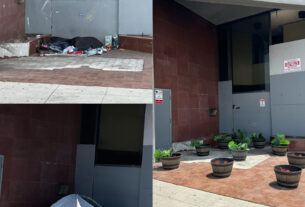Doves aren’t a part of my family’s holiday celebrations, but they seem to have been for the rabbis. If you had to gather doves to eat on the day of the festival itself, you might have to climb a ladder to reach them in their dovecote (a shelter for domesticated birds). But what if the ladder is not in the right place?
That’s the subject of a dispute in a mishnah on today’s daf:
Beit Shammai say: One may not carry a ladder from one dovecote to another. However (one may move it slightly so that) he tilts it from one window to another (in the same dovecote). And Beit Hillel permit (even carrying a ladder from one dovecote to another).
In the Gemara, Rav Hanan bar Ami suggests that the dispute here is only about moving the ladder in the public domain. Beit Shammai is concerned that if a person sees another person carrying a ladder they may suspect them of doing something forbidden, like fixing a leak in their roof. This concern, known as marit ayin, holds that certain actions that are technically permitted should nonetheless be forbidden because they appear to be violations.
To avoid this problem, Beit Shammai forbids moving the ladder. Beit Hillel is unconcerned about marit ayin in this case and permits moving the ladder, perhaps because dovecotes have unique ladders so no one would think that you are fixing your roof. Or perhaps because the ladder carrier will escape suspicion when they are seen placing the ladder in a dovecote.
Whatever the reason, Rav Hanan bar Ami says that in private, both parties agree that a ladder can be moved. But the Gemara objects:
Didn’t Rav Yehuda say that Rav said: Wherever the sages prohibited an action due to marit ayin, even in the innermost chambers, where no one will see it, it is prohibited.
According to Rav, the principle of marit ayin makes no distinction between public and private actions. If an action done publicly creates a marit ayin issue, the action should not be done in private either.
This creates a problem for Rav Hanan’s explanation. If Rav Hanan is correct, it means either that Beit Shammai is going against the sages, or that Rav (an amora, or a later rabbinic authority) is challenging Shammai (a tanna, an earlier rabbinic authority), which is generally a no-no.
The Gemara cites this beraita (early rabbinic teaching) to resolve the problem:
One whose clothes fell into water on Shabbat or a festival may spread them out to dry in the sun, but he may not do so opposite the masses, i.e., in a place where people can see him, lest they suspect him of laundering on Shabbat. However, Rabbi Eliezer and Rabbi Shimon prohibit (doing so even in private).
This beraita establishes that even the early rabbinic authorities disagreed about whether marit ayin should apply in private. Beit Shammai’s position in the mishnah is in line with the first (anonymous) opinion, and Rav’s position is in line with Rabbi Eliezer and Rabbi Shimon.
If this conversation sounds familiar, that’s because it is. A mishnah on Shabbat 146 taught that a person whose clothes fell into water on Shabbat can spread them out to dry as long as it was done in private, in line with the anonymous opinion quoted above. Just as on today’s daf, the Gemara responded by quoting Rav to respond to the mishnah and cites the baraita to demonstrate that the dispute is between tannaim.
We also saw these texts on Shabbat 64 and 65, where the Talmud discusses objects that women can carry in a karmelit (an intermediary place that is neither public nor private) even though they are prohibited from doing so in public.
While studying Daf Yomi, you’ll for sure encounter statements, or even whole discussions, that you’ve seen before. If you don’t remember exactly where you saw them, Masoret HaShas, a commentary printed in the margins of the Vilna edition of the Babylonian Talmud, can help you find the specific source, as can the links embedded in the text of the Talmud found on Sefaria.
These repetitions remind us that the Talmud is a self-referential document that evolved over long periods of time. The beraita about wet clothing and Rav’s statement about marit ayin represent early layers of the text. That they appear together in three locations might suggest that they came to be linked together at an early stage as well. Contemporary talmudic scholarship is, in part, focused on examining these layers to understand the history of the text and parallel discussions like these are often fruitful places to investigate. If you are interested in this topic, check out Josh Kulp and Jason Rogoff’s Reconstructing the Talmud, which address this and other matters about how the text of the Talmud came together over time.
And make a mental note to keep your eyes open for Rav’s statement, which we’ll see again on Avodah Zarah 12.
Read all of Beitzah 9 on Sefaria.
This piece originally appeared in a My Jewish Learning Daf Yomi email newsletter sent on September 9th, 2021. If you are interested in receiving the newsletter, sign up here.
The post Beitzah 9 appeared first on My Jewish Learning.




